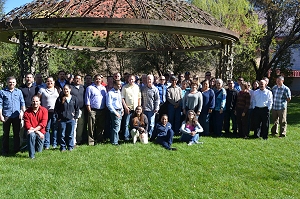The California Area Indian Health Service works to improve the health of California Indians, in part by providing quality environmental health, health facility and engineering services throughout California. IHS employs experts in sanitation, water supply, wastewater and solid waste disposal, health facilities engineering, injury prevention, food safety inspections, disease outbreaks and other specialties. These experts serve communities directly and they also provide technical assistance and training to Tribes, Tribal health facilities and other organizations serving American Indians and Alaska Natives.
From 2012 to 2015, the state of California experienced severe drought conditions, the driest four-year period ever recorded. In January 2014, the governor declared a drought state of emergency and then later, in April 2015, the governor directed the state Water Resources Control Board to implement mandatory water reductions in urban areas. Like everyone else in California, IHS and the Tribes, Tribal organizations and individuals we serve were affected.

During this critical drought period, the IHS California Office of Environmental Health & Engineering implemented activities, led by Donald Brafford, director of Sanitation Facilities Construction (SFC), and Capt. Chris Brady, SFC deputy director, to collaborate with Tribes and other government agencies, carry out periodic vulnerability and risk assessments, monitor at-risk systems, provide technical assistance for water quantity and water quality issues and implement emergency planning. The most exciting highlights include:
- Served an estimated 6,000 Tribal members through 22 projects valued at $6.5 million that improved water treatment, water main repair/leak reduction, water tank rehabilitation/leak reduction, watering stations, water hauling services and related issues. Resources and funding were contributed by Tribes, California State Water Resources Control Board and California Department of Water Resources , United States Environmental Protection Agency , United States Department of Agriculture/Rural Development , United States Department of Housing and Urban Development Imminent Threat Funds and Indian Health Service regular and emergency projects.
- Helped to increase the percentage of Tribes having a drought contingency plan from 20 percent to 65 percent, by creating, sharing and assisting Tribes with completion of the contingency plan.
- Enhanced collaboration between government agencies. The Drought Planning Handbook, Emergency Drinking Water Supply for California Indian Tribes is a collaboration with 11 state and federal agencies and provides a framework for effective response among government stakeholders providing resources to Tribes for emergency drinking water supply. Download the Drought Planning Handbook here.
- Published a drought portal on the IHS website, making drought-related information available to Tribes and other stakeholders.
The precipitation for water year 2016, from October through January, was about 115 percent of average statewide. While this is much needed good news, many areas of the state are still facing critical drought conditions. IHS will build upon the past successes coordinating and collaborating in order to respond even more effectively in 2016 and beyond.
Ms. Miller, a member of the Cherokee Nation of Oklahoma, joined IHS in 1993. The California Area IHS serves 104 Tribal communities through 44 rural health care operating units, eight Urban Indian Health programs, and two alcohol treatment programs.



